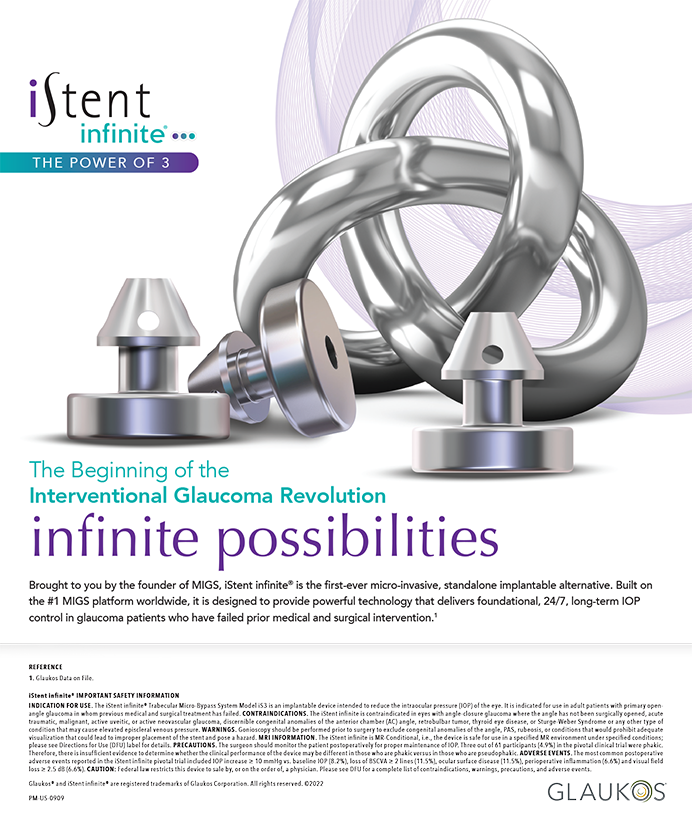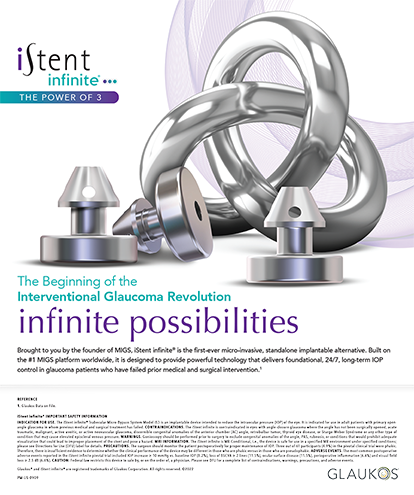Patients' rising expectations for improved quality of vision are driving surgical and technological innovation and blurring the traditional lines between cataract and refractive surgery. We surgeons are also becoming aware that our conventional measurements of visual acuity do not always correlate with how well patients can see to perform their daily activities. We use the term functional vision, defined as the ability to see clearly while performing daily activities in varying levels of light, to provide a basic foundation from which to address this issue.
The Tecnis IOL (Advanced Medical Optics, Inc., Santa Ana, CA) was designed to improve patients' quality of vision as well as their Snellen visual acuity. It was the first IOL to incorporate a modified anterior prolate surface to reduce the spherical aberration of the eye after cataract surgery.1 This article describes why it is my aspheric IOL of choice and why I offer this lens to the majority of my patients receiving a standard monofocal IOL.
BACKGROUND
People's contrast sensitivity declines with age2 (Figure 1). Guirao et al3 and Glasser and Campbell4 have shown that the decrease is due to an increase in the spherical aberration of the eye and a resultant loss of balance between the spherical aberration in the cornea versus the crystalline lens. In the youthful eye, the crystalline lens' negative spherical aberration balances the positive spherical aberration of the cornea to produce a sharp focal point inside the eye. In the aging eye, the corneal spherical aberration remains positive, but that of the crystalline lens becomes increasingly positive. As a result, the quality of vision decreases.3,4
COMPARISONS AND FDA DATA
Traditional spherical IOLs provide clear optical media improving a patient's Snellen acuity, but they do not address spherical aberration (Figure 2). Postoperatively, patients have residual spherical aberration that reduces their contrast sensitivity and quality of vision. The Tecnis IOL, however, decreases the spherical aberration present in the optical system.1
Unlike the Acrysof IQ lens (Alcon Laboratories, Inc., Fort Worth, TX) and the Sofport AO lens (Bausch & Lomb, Rochester, NY), the Tecnis IOL was designed based on data on corneal spherical aberration taken from the general population. Developers used wavefront information from this general population when designing the lens' modified anterior prolate surface. Data from the controlled, multicenter, intraindividual, FDA clinical investigation showed that postoperative spherical aberration was significantly less with the Tecnis compared with a spherical acrylic lens. This benefit was independent of age. One reason I favor this lens is that it is the only aspheric IOL to have undergone FDA clinical trials. My patients derive confidence from knowing that rigorous FDA trials support the claims that the Tecnis lens improves recipients' quality of vision and visual acuity at night5 (Figure 3).
The data from the FDA trial also showed that the Tecnis lens improved subjects' brake-reaction time by 0.5 seconds. This change gave them a 45-foot advantage (approximately four to five car lengths) in identifying and avoiding obstacles when driving at 55mph. Based on these data, the FDA approved labeling on the package insert that Tecnis lenses are likely to contribute meaningfully to the safety of the elderly drivers who receive them as well as to that of other drivers and pedestrians. The insert also states that these IOLs improve recipients' functional vision and thus may make these individuals safer in low-visibility conditions5 (also D. K. McBride and W. Matson, unpublished data on file with the Potomac Institute for Policy Studies, 2003).
The relevance of these substantiated claims is evident in the results of a survey of adults aged 55 to 75 years in which participants answered questions about common visual concerns and the treatment of visual loss (A. C. Nielsen, unpublished data on file with Advanced Medical Optics, Inc., 2004). Eighty-eight percent stated that they were "extremely" or "very" concerned about not being able to drive, especially at night. In a similar vein, 91 said it was "extremely" or "very" important to have a lens implant that made driving safer, especially at night. Finally, 89 of respondents stated that it was "extremely" or "very" important to receive the lens implant that restores the eye's function to that of a healthy young adult rather than a healthy older one.
DETAILS ON THE TECNIS LENS
The Platform
The Tecnis IOL is available on both a silicone and an acrylic platform. Both are three-piece foldable lens platforms that can be injected into the eye by means of the Unfolder series of lens implanters (Advanced Medical Optics, Inc.). The acrylic model features the company's Optiedge design to minimize potential dysphotopsia and posterior capsular opacification. It has an overall length of 13mm, which I have found to allow easy, stable, well-centered implantation, even in the ciliary sulcus. The new silicone model's features will be identical to those of the acrylic model.
Patient Selection
Based on research by P. A. Piers, MSc (unpublished data on file with Advanced Medical Optics, Inc., 2004), 96 of the population should achieve their best possible vision with the Tecnis instead of a spherical IOL (Figure 4). I still prefer spherical lenses, however, for patients who have undergone hyperopic LASIK or PRK for greater than 2.00D, because these treatments result in negative spherical aberration that the Tecnis IOL would exacerbate.
CONCLUSION
The Tecnis IOL optimizes patients' vision after cataract surgery and may meaningfully improve their safety postoperatively. Moreover, offering this technology helped my staff and me begin to think in terms of refractive IOLs. We started evaluating cataract patients preoperatively as potential candidates for refractive surgery. The workup included a topographical examination and immersion A-scan biometry, an approach that later helped my staff to incorporate presbyopia-correcting IOLs into our practice.
With continued advances in the understanding of spherical aberration and the instruments for its measurement, surgeons may become capable of choosing IOLs customized to patients' axial lengths and their preoperative level of corneal spherical aberration.
Y. Ralph Chu, MD, is Medical Director of the Chu Vision Institute in Edina, Minnesota. He is a consultant to Advanced Medical Optics, Inc. Dr. Chu may be reached at (952) 835-1235; yrchu@chuvision.com.


